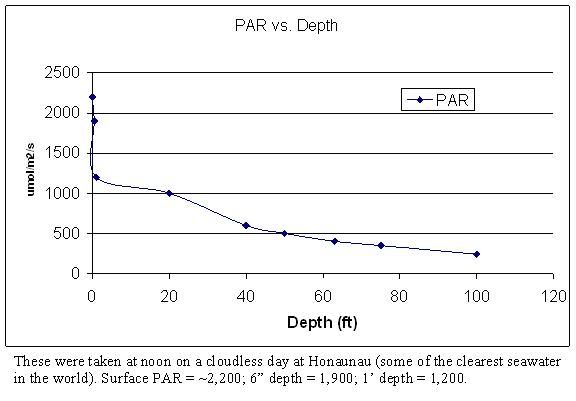Now, for the REAL info that you might like...
PAR at depth, as per emails with Dana (thanks Dana, you rock!):


Thats why 'daily amouts' are important. You can overexpose a coral over the course of a day by giving it just as much as in nature... since the peak value only happens for a fraction of the day underwater. What we give corals in our tanks would look not like a bell curve, but a couple steps up, and a couple down, or maybe not even... maybe just a square (lights come on, stay on all day w/o varying in intensity or position, then turn off). So calculating the total is most important.
Then, consider the depth that the coral comes from... a coral that comes from 5m will get alot more light than one from 15m. If you use the top graph, you will see that basing any captive system on what the ocean gets at the surface is useless. What matters is at the coral. In nature, the surface might be at '1800', but only 400 at a coral's depth. Well, in a captive system, the intensity at the surface might only be 500, yet still 400 at the corals depth because the coral is only 6" below the water's surface.
Then there is spectrum as well. As per Sanjay's article here:
http://www.advancedaquarist.com/2005/8/aafeature/view
You will see how light changes very fast as it filters throught water:

(see those numbers on the left... those are actual energy readings, not 'relative' numbers).
So those 'bluer bulbs that try to manipulate the PAR reading by being so blue'... they are just giving the coral what they are used to if they are from deeper water. Thats all.
I hope that gets you on the right track. I hate to see people, esp ones who link themselves to being a mfg of lighting products like you have, to spread bad info. It hurts everyone in the end.